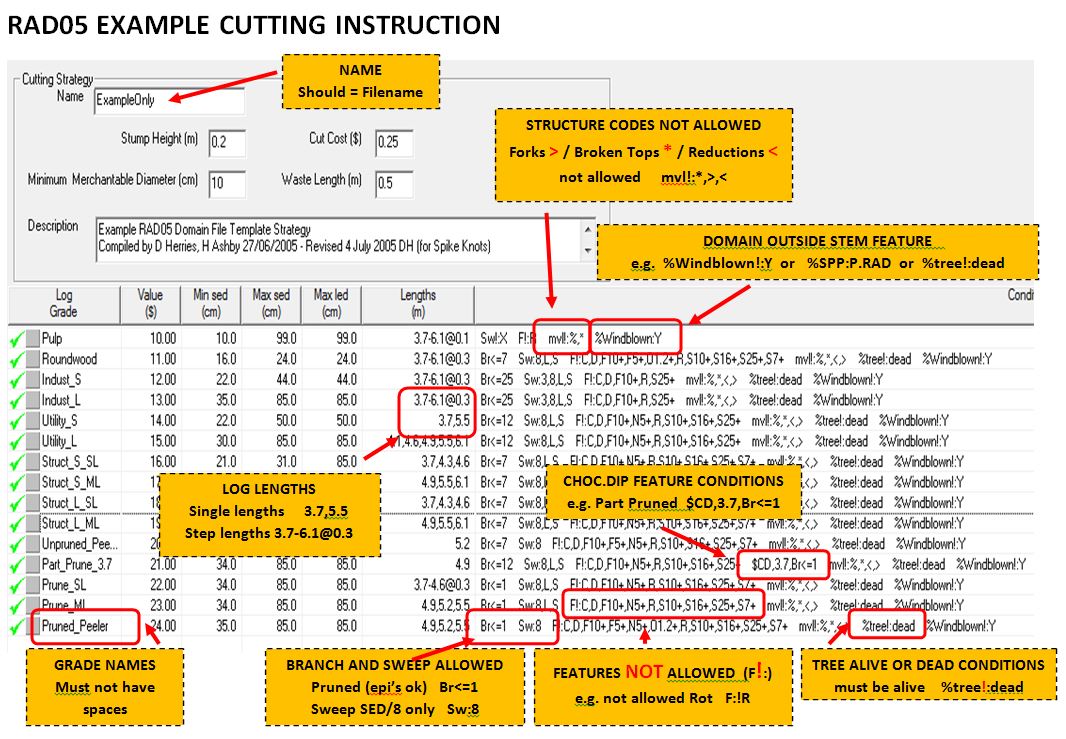One of the foundations within YTGen is its flexibility when it comes to choosing which log grades to produce. The Cutting Strategy (*.YTS file) options within YTGen offers the user a wide range of options to define different types of log products. These can be carefully defined to produce the required log grade specification depending on the cruising dictionary used (e.g RAD05).
Figure 1 below shows an example of generic cutting strategy with explanations of the typical types of definitions given to define a log grade.
Figure 1 Annotated Cutting Strategy Designer in YTGen showing implementation of the RAD05 Cruising Dictionary
As you can see there is a wide range of conditions and constraints that can be applied to log grades.
- Dimensions include length, and diameter (now also includes min and max middle diameter).
- Conditions where a section of stem which is a candidate for the production of a log of this grade must satisfy all of the conditions associated with the grade. These are based on the cruising dictionary (e.g. RAD05) that has been used in the field.
Tips on Defining a Log Grade for RAD05, RAD06 or RAD05A
- Branches (Br) are often numeric values for these cruising dictionaries and can be easily defined as “must have” i.e. Banching must be less than 7cm; Br<=7. These reason for defining the condition as “must have” is that generally the full tree will always be cruised for Branching. Where a log grade like pulp allows all branching types you can simply not define it as is shown in Figure 1 for Pulp.
- Sweep (Sw) is a string value and is also cruisied for entire stem, so are often best defined a “must have” but must also be inclusive of any higher quality. That being if the log grade accepts SED/4 then ensure you include SED/8 as well in the definition; SW:8,L,S
- Stem Features (F) are only defined where they exisit so a stem might not have any stem features assessed, so these are best defined as “must not have” so you will often find more features defined as not being allowed for a pruned grade than an industrial. Again these are string values so must be defined in full and inclusive. For example if a log grade is not allowed Fluting >5cm then you must also include the code that is used where fluting is >10cm; F!:F5+,F10+
- Chocolate Dip ($CD) is used for Part Pruned logs, and as shown in the above example this is 3.7m of the stem must be pruned.
- Structural Codes (mvl) are; Forks < / Broken Tops * / Reductions > / Forced Cuts %” These are generally not allowed in most log grades except pulp. Note that forced cuts are no longer used in RAD05, RAD06 or RAD05A and can be left out of the definition (this is a carry over from some older data upgraded from MARVL A-Z style cruising, and hence their inclusion here).
- Sound dead trees are a little special as defined in YTGen and cruising dictionaries such as RAD05. Generally we include them only in pulp grades, but if you are growing the trees sound dead trees will automatically be downgraded 6 month after inventory date to non recoverable waste due to a inbuilt assumption that they will be rotten after this time period; %tree!:dead
- Another exclusion which is specific to these cruising dictionaries is the definition of LIVE windblown trees (where often the roots are still attached but are >45 degrees lean). Conservatively we exclude these from all grades including pulp, but this is upto the resource analyst to decide but it is important to remember that as defined in the field procedures field crews will not assess stem quality (Br,Sw,F) on any LIVE windblown trees; %Windblown!:Y
If you have any questions on creating strategies or would like us to create custom cutting strategies for you, feel free to contact us to help.
